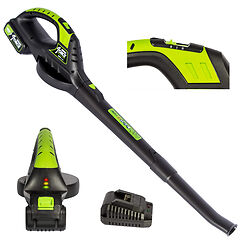
September 14th, 2021 by
Leaf blowers are really useful for clearing up all the leaves that fall into your garden. They’re handy all year round but especially so in the autumn and while they have always been widely used in America, they are growing in popularity here too. Not surprising when they make such short work of what can be, a back-breaking task.
Because we’re not as familiar with leaf blowers, and because all power tools require a safe and sensible operation, here is our guide to using a leaf blower effectively and safely.
1. Preparation
As with most tasks, some prior preparation is always a good idea.
Prepare yourself
Start by making sure you are suitably attired for the job. It won’t just be leaves that you blow around; there will be twigs, stones, dirt, and debris in the mix as well so wear goggles to protect your eyes and you may want to wear a mask as well to protect you from breathing in dust and dirt. Long sleeves and trousers are not a bad idea, and you ought to tie back long hair or wear a hat.
Prepare the area
Pre-plan where you want the leaves to end up. The idea of a leaf blower is that all the leaves are accumulated into a single pile that can be easily picked up. The easiest way to dispose of them once you have them gathered is to lay some kind of tarp or sheet so that you can pick the whole pile up at once and transfer it to a bin, bag, or composter. Pick an appropriate spot and lay your sheet here.
Plan your power needs
If your leaf blower is cordless, make sure the battery is charged. If it is a corded machine, ensure you have a sufficiently long extension lead to move around the area.
MYLEK 4orce Cordless Leaf Blower
Price: £85.00
Buy Now
2. Using your leaf blower
Once you are prepared, you can start work:
Start with difficult areas
Begin with the areas that are harder to get to such as close to buildings or around fences or hedges. Blow them into the open first and then start guiding them to where they need to be.
Work sideways
Many people work forwards with a leaf blower, clearing a path in front of them, blowing leaves out to the left and right. You will have more control, and direct more of them in the same direction by holding the leaf blower at a right angle from your body and moving sideways.
Technique
Hold the blower at a shallow angle and swing it smoothly in a U shaped motion, rather than trying to blast the leaves quickly.
Work towards your endpoint
 Always bear in mind where you ultimately want the leaves to end up (where you have laid your sheet) and gradually work towards this. You can almost think of it as ‘herding’ the leaves into place just as a sheepdog rounds its sheep up, working your way around the outsides until they’re all in place.
Always bear in mind where you ultimately want the leaves to end up (where you have laid your sheet) and gradually work towards this. You can almost think of it as ‘herding’ the leaves into place just as a sheepdog rounds its sheep up, working your way around the outsides until they’re all in place.
3. Top tips
As with most tasks around the home, there are a few tips to keep in mind to get the best results:
Use your leaf blower when leaves are dry
Leaves become heavy and will stick together when they are wet so give them chance to dry out before trying to move them.
Avoid windy days
Using your leaf blower on a breezy day is just counter-productive. Even if the wind is blowing in the direction you want to go, you will have far more control if you are in charge of all the blowing during the task.
Use the vacuum for hard to reach areas
Some leaf blowers also have a vacuum function. This is best used for the harder to reach areas such as in corners or under hedges.
Be considerate
Like many power tools, leaf blowers will make some noise. Be considerate to your neighbours by not using it very early in the morning or late at night and, if you have a large area to cover, maybe consider wearing some ear defenders to protect your own hearing.
Comments
Leave a reply
Your e-mail address will not be published. All fields are required


